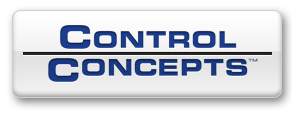ABOUT CONTROL CONCEPT’S MOTOR DRIVE SERVICES
We service and repair most drive types, including Variable Frequency Drives (VFDs)
Other drive types we service:
- Mechanical
- Hydraulic
- Eddy-Current
- Rotating DC
- Electronic - DC
- Electronic - AC
Most drives installed today for automation are variable frequency drives or VFDs. A VFD takes fixed AC voltage and frequency input, converts it to DC internally, then sends it out as variable voltage and frequency AC output.

A VFD is pretty much a computer and a power supply that controls the torque, speed, and direction of an AC induction motor.
In more exhaustive detail, this is what a variable frequency drive does:
- Control circuitry coordinates the switching of power devices through a control board that governs the discharge of the power components in the right sequence.
- A microprocessor or digital signal processor (DSP) performs decisions through internal logic programming.
- The motor speed is varied by changing the voltage and frequency to match that needed by the output device.
- Motor torque is maintained by keeping the volts-to-frequency ratio constant.
In other words, the VFD translates one voltage and frequency to another to change motor speed without losing torque.
SMART(S) Troubleshooting
SMARTS, a term borrowed from Solomon S. Turkel at ECMweb.com, is a reminder of the steps in troubleshooting intelligently.
S is for Safety. Before we do anything, we make sure we are not endangering ourselves, our customers, or the equipment.
M stands for Manual. Every microprocessor based control has a smart display to show the results of any on-board diagnostics. Without the manual, the display is full of arcane symbols without meaning. The manual explains everything.
A is Application. We do not troubleshoot individual pieces of equipment; we troubleshoot the application. Most often the trouble is due to outside conditions rather than a faulty drive.
R is for Readings. We check the line voltage and motor current to find out if the incoming power line is “dirty” or allowing electrical spikes and unstable voltages to enter the equipment. We also take the temperatures of the heatsinks, which could clue us into potential issues in the future.
T - we talk. We talk to the operators and users of the equipment because they are most familiar with it and were there when the problem occurred.
The final S is for Simple Solutions. We keep things as uncomplicated as possible and try the simple solutions first before we advance to more complex and costly ones.
Common Problems
VFDs and most other drives are simple devices that are highly reliable. Problems are usually rooted in another part of the machine.
- Loose connections
- Cooling fan failure causing an over-temp fault
- Drastic failure of the power semiconductors
- Time to replace the electrolyte capacitors
- Issues with programming
- Circuit board
Circuit board failures are much less common than the rest; an experienced technician does not start troubleshooting a VFD problem with the circuit board.
If we suspect programming is at fault, we find out if everything was working before programming was changed. We put the old programming in place to see if that fixes it. Often it does.
The most common fault that shuts down a drive is an overcurrent fault of which there are 20 to 30 causes. We start with the dynamics of the motor and load and then move on from there.
You can reduce potential problems with a little maintenance:
- Keep the drive dust-free
- Ensure proper ventilation
- Keep things dry and protected from moisture




































